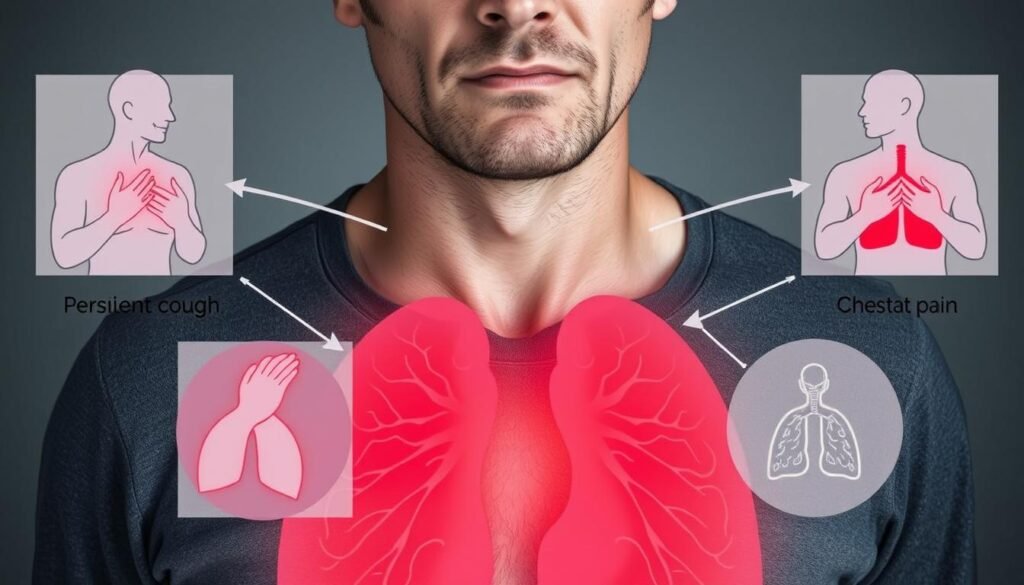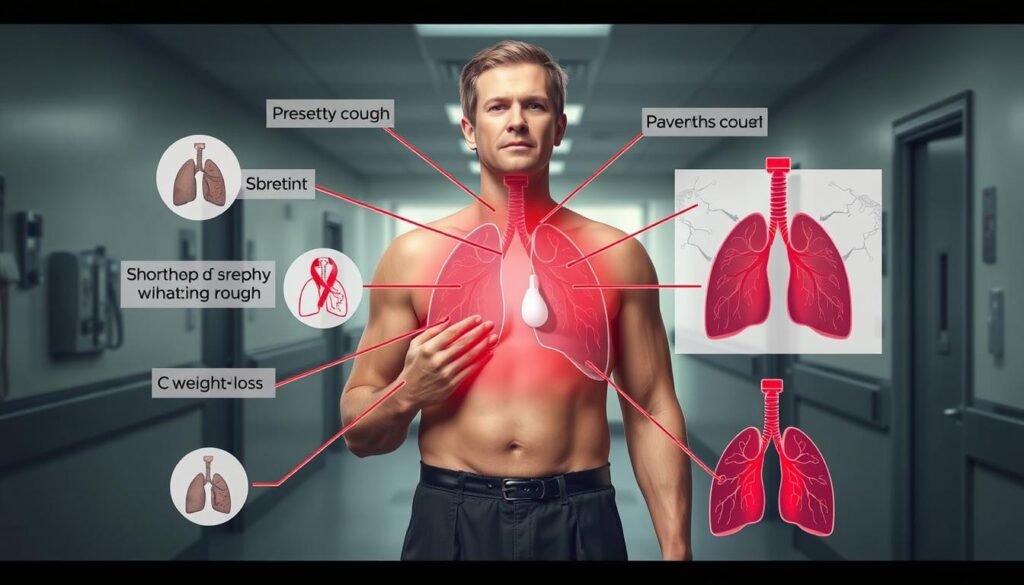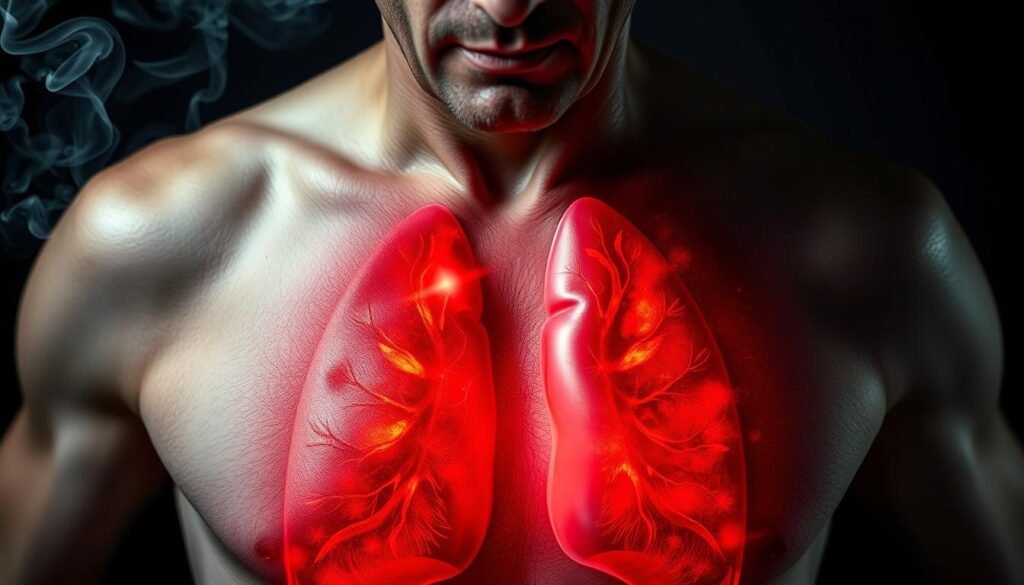Did you know smoking causes almost 90% of lung cancer in men? This important fact points out how vital it is to know the signs of lung cancer in men. Lung cancer leads to many cancer deaths and often does not show symptoms early. Spotting these signs early is key to fighting the disease.
It’s crucial to understand the symptoms of lung cancer in males. This is because men and women might have different symptoms due to their bodies. For men, common signs are a continuous cough, pain in the chest, and dropping weight fast. Keeping an eye out for these symptoms could catch the cancer earlier. This can help get better results from treatment. Discover more about lung cancer and gender differences here.
Key Takeaways
- Smoking is responsible for 90% of lung cancer cases in men.
- Early symptoms may include persistent cough and unexplained weight loss.
- A chest x-ray is recommended for those over 40 with persistent symptoms.
- Men may experience unique symptoms compared to women due to biological differences.
- Timely recognition of symptoms can significantly improve treatment outcomes.
Understanding Lung Cancer in Men
Lung cancer is the top cancer killer in men. Two main types are there: non-small cell lung cancer (NSCLC) and small cell lung cancer (SCLC). NSCLC grows slowly, while SCLC spreads quickly. It is key to catch it early, but signs can depend on the cancer type.
Smoking is behind 90% of lung cancers in men. Being around smoke can also raise your risk. Jobs with exposure to harmful stuff like asbestos add to this risk too. High air pollution levels are also dangerous.
Men with lung cancer might cough a lot or feel pain in their chest. They could also have trouble breathing. Sudden weight loss and coughing up blood are serious signs. SCLC often leads to nerve and hormone problems. On the other hand, NSCLC can damage nerves in the top part of the lung. Each kind needs different treatments, like surgery or chemo.
We need to fight the shame of lung cancer, especially for men who smoked. Knowing the truth helps. If you have symptoms, getting help is important. For treatment details, check out this resource.
| Type of Lung Cancer | Common Symptoms | Progression Rate | Associated Syndromes |
|---|---|---|---|
| Non-Small Cell Lung Cancer (NSCLC) | Cough, Chest Pain, Weight Loss | Slow | Horner Syndrome |
| Small Cell Lung Cancer (SCLC) | Hoarseness, Severe Coughing, Fatigue | Fast | Paraneoplastic Syndromes |
The Importance of Early Detection
Early detection of lung cancer is key to improving treatment success and survival rates. About 224,000 new lung cancer cases were expected in 2016, leading to around 158,000 deaths that year. The 5-year survival rate for this disease is about 18%, much lower than rates for breast, colon, and prostate cancer.
Screening methods like low-dose computed tomography (LDCT) are promising for finding lung cancer early. The National Lung Screening Trial (NLST) showed LDCT screening could cut mortality by 20% in high-risk populations. Around 63% of lung cancers found through LDCT screening were at stage I, which is more treatable than stages III or IV.

Routine screenings are critical for high-risk groups, especially males over 65 or those who smoke. Following the NLST results, several health organizations now support LDCT screening. It could prevent about 12,250 lung cancer deaths each year in the U.S. It’s vital to know the warning signs of lung cancer in males.
Common Lung Cancer Symptoms in Males
Lung cancer symptoms in men can appear in many ways. This can lead to mistaking them for less serious conditions. It’s important to know these signs for early lung cancer detection and treatment.
A cough that doesn’t go away can be an early warning. If a cough gets worse or lasts a long time, it might mean something serious. Chest pain that gets sharper with a deep breath or a cough is another key sign. Men might also get sick often with things like bronchitis or pneumonia, which can happen with lung cancer.
Feeling very tired or weak is also something to watch for. According to the American Cancer Society, lung cancer can cause anemia. This happens when the body’s tissues don’t get enough oxygen, leading to low energy levels.
| Symptom | Description | Frequency |
|---|---|---|
| Persistent Cough | Worsening cough that does not improve | Common |
| Chest Pain | Pain increases with coughing or deep breaths | Common |
| Frequent Respiratory Infections | Recurrent cases of bronchitis or pneumonia | Common |
| Extreme Fatigue | Persistent tiredness due to anemia | Notable |
Men often ignore these signs, thinking they are normal. But being aware and talking to a doctor can greatly help in dealing with lung cancer symptoms in men.
Lung Cancer Signs in Men
Knowing the signs of lung cancer in men is key for early treatment. Catching these symptoms early can lead to better results. Here are the most important signs:
Persistent Coughing
A cough that stays or gets worse can be a sign of lung cancer. This cough is different from one from a cold. It’s a serious symptom that could mean lung cancer is starting.
Coughing Up Blood or Rust-Colored Sputum
Seeing blood or rust-colored mucus when coughing is serious. It often points to lung cancer. If this happens, see a doctor right away.
Chest Pain and Discomfort
Chest pain, whether sharp or dull, may link to lung cancer. Pain can get worse with movements or deep breathing. Persistent chest pain should be checked out.
Shortness of Breath
Having trouble breathing can be a sign of late lung cancer. Don’t ignore this symptom. It needs fast medical help.

Early Warning Signs of Lung Cancer for Men
It’s important to know the early signs of lung cancer in men to help improve outcomes. Symptoms can be easy to miss at first. A key sign is a cough that doesn’t go away, even when there’s no clear reason for it. Men might also cough up blood or rust-colored spit. This is a big red flag, especially for those who have smoked before.

Losing weight without trying and not feeling hungry can also mean there’s a serious problem, like lung cancer. Also, getting sick often, with things like bronchitis or pneumonia, might show there’s a bigger issue with the lungs. Paying attention to these signs can lead to getting help and possibly a diagnosis early on.
| Symptom | Significance |
|---|---|
| Persistent Coughing | Often a primary warning sign, indicating potential lung issues. |
| Coughing Up Blood | Could signal serious conditions, necessitating immediate medical attention. |
| Unexplained Weight Loss | May indicate cancer or other serious health problems. |
| Loss of Appetite | Can be a warning sign related to various medical conditions. |
| Recurrent Infections | Frequent respiratory infections could hint at more severe issues, including lung cancer. |
Being aware and proactive about lung cancer signs in men can lead to early detection. Early diagnosis means better options for treatment. This can greatly improve outlook for those affected.
Advanced Symptoms and Indicators
Lung cancer gets more serious as it grows, showing symptoms that affect the body more. Spotting these signs is key to getting the right help quickly.
Bone Pain and Weakness
Bone pain, especially in the back, hips, and legs, is a clear warning. It often means the cancer has spread to bones. Men might brush it off as aging, but it could be lung cancer.
Nervous System Changes
If you start having constant headaches, feeling dizzy, or weakness in your arms or legs, pay attention. These could be from lung cancer reaching the brain. Knowing this early can help start treatment sooner.
Swelling of Lymph Nodes
Swollen lymph nodes in the neck or collarbone area can mean lung cancer has spread. It’s the body reacting to cancer. Seeing this swelling should make you talk to a doctor early on.
To learn more about how serious lung cancer can get, check out this source. Knowing these symptoms can lead to quicker checks and better chances of getting better.
Male-Specific Lung Cancer Symptoms
Identifying lung cancer signs in men can greatly improve treatment success. It focuses on symptoms mainly found in men. Early detection can lead to better treatment and management.
Hoarseness and Voice Changes
Hoarseness could mean a tumor is affecting the vocal cords. Voice changes can be minor or major, and alarming. These signs, particularly in men, should not be ignored, especially if they last a long time.
Weight Loss and Loss of Appetite
Unexplained weight loss and less appetite are key signs of serious lung cancer. These occur when the body can’t take in nutrients well. Knowing these signs can push men to get medical help sooner.
Fatigue and Weakness
Men with lung cancer often feel very tired and weak. This is because their lungs don’t work well, affecting oxygen levels in the blood. Also, the disease itself can make you feel this way. It’s important to act quickly to address these symptoms.
| Symptom | Indication | Recommended Action |
|---|---|---|
| Hoarseness | Tumor involvement in vocal cords | Consult an ENT specialist |
| Weight Loss | Potential advanced disease | Schedule a comprehensive health evaluation |
| Fatigue | Reduced lung function | Monitor symptoms and discuss with a healthcare provider |
Conclusion
It’s vital to know about lung cancer signs in men for early help and better chances of recovery. Knowing these signs leads to quick doctor visits. This is key for better results from treatments. It’s a fact that lung cancer is the top cause of cancer deaths in the USA. Sadly, most cases are due to smoking.
Stats show that early-stage lung cancer has a 65% chance of survival. But, this chance drops as the cancer grows. Since 80% of lung cancer deaths come from smoking, it’s crucial for men who smoke to get checked often. Knowing the early signs can massively change the outcome for better.
Men should watch out for any worrying symptoms and talk to a doctor fast. To know more and look into screening options, click here. Being aware, educated, and taking action early is key to fighting lung cancer. This boosts the chances of surviving the disease.